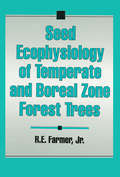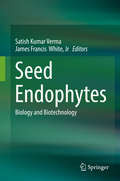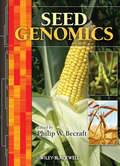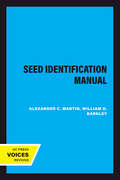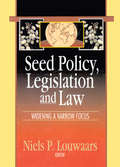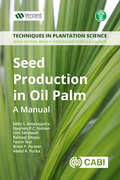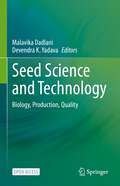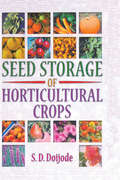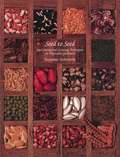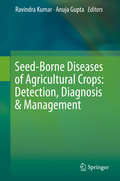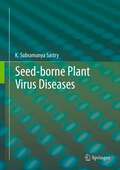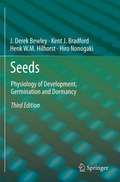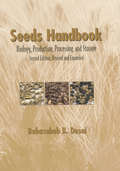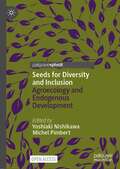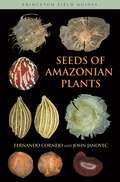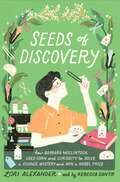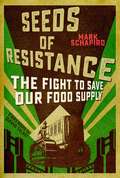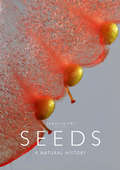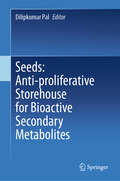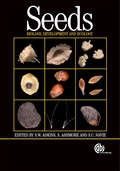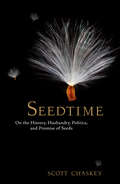- Table View
- List View
Seed Ecophysiology of Temperate and Boreal Zone Forest Trees
by RobertE. FarmerThis is the first truly modern book solely devoted to seed reproduction of forest trees-from flowering to establishment, with emphasis on the interaction of environment with physiological processes.Focus is on seed function in natural settings and the application of information to natural regeneration of forests. This easy-to-read text addresses important principles and provides in-depth coverage of existing literature.Presentation of the information is organized to allow for a natural development of the main theme with full explanations of such important components as seed production, dispersal and germination, as well as the integral parts played by water, temperature, light, chemicals, animals, pathogens and aging.A highly useful book for investigators, practitioners or students.
Seed Endophytes: Biology and Biotechnology
by Satish Kumar Verma James Francis White JrThis book focuses on the importance and roles of seed microbiomes in sustainable agriculture by exploring the diversity of microbes vectored on and within seeds of both cultivated and non-cultivated plants. It provides essential insights into how seeds can be adapted to enhance microbiome vectoring, how damaged seed microbiomes can be assembled again and how seed microbiomes can be conserved. Plant seeds carry not only embryos and nutrients to fuel early seedling growth, but also microbes that modulate development, soil nutrient acquisition, and defense against pathogens and other stressors. Many of these microbes (bacteria and fungi) become endophytic, entering into the tissues of plants, and typically exist within plants without inducing negative effects. Although they have been reported in all plants examined to date, the extent to which plants rely on seed vectored microbiomes to enhance seedling competitiveness and survival is largely unappreciated. How microbes function to increase the fitness of seedlings is also little understood. The book is a unique and important resource for researchers and students in microbial ecology and biotechnology. Further, it appeals to applied academic and industrial agriculturists interested in increasing crop health and yield.
Seed Genomics
by Philip W. BecraftThis up-to-date review of seed genomics, from basic seed biology to practical applications in crop science, provides a thorough background understanding of seed biology from a basic science perspective. A valuable resource for advanced graduate students, post-docs, researchers and professionals in the Plant and Crop Sciences, this book brings together top researchers in the field to cover three general themes: genomic approaches to studying seeds, genomic analysis of basic seed biology, and crop seed genomics.A valuable resource for advanced graduate students, post-docs, researchers and professionals in the Plant and Crop Sciences
Seed Identification Manual
by Alexander C. Martin William D. BarkleyThis title is part of UC Press's Voices Revived program, which commemorates University of California Press’s mission to seek out and cultivate the brightest minds and give them voice, reach, and impact. Drawing on a backlist dating to 1893, Voices Revived makes high-quality, peer-reviewed scholarship accessible once again using print-on-demand technology. This title was originally published in 1961.This title is part of UC Press's Voices Revived program, which commemorates University of California Press’s mission to seek out and cultivate the brightest minds and give them voice, reach, and impact. Drawing on a backlist dating to 1893, Voices Revived</DIV
Seed Policy, Legislation and Law: Widening a Narrow Focus
by Neils P LouwaarsLearn what it takes to create and implement a truly successful seed policy!This unique book brings together international experts on seed policy and law. While other books approach the subject from the perspective of seed industry development and privatization, Seed Policy, Legislation, and Law makes clear that a successful national seed
Seed Production in Oil Palm: A Manual (Techniques in Plantation Science #1)
by Brian Forster Eddy S Kelanaputra Steven P. Nelson Umi Setiawati Baihaqi Sitepu Fazrin Nur Abdul R. Purba Peter D. CaligariThis is a practical guide to seed germination in oil palm for both breeding and genetic studies as well as commercial seed production. Oil palm is the top oil crop in the world and this manual provides step-by-step illustrated methods, written by practitioners actively engaged in oil palm seed production and breeding. Presenting sound practices based on scientific innovation and knowledge, this guide brings together the many aspects of seed germination in oil palm in one place. Promoting green, eco-friendly agriculture, this book covers: Health and safety considerations Pollination and harvesting Seed preparation, viability testing and moisture testing Seed processing for commercial production and breeding Based on experience and protocols, this is an invaluable manual for students and researchers in agriculture, plant breeders, growers and end users interested in the practicalities of oil palm seed production. It is also a valuable resource for training, for those entering a career in oil palm and as a reference for managers , to ensure best practices in maximising sustainability and production of this important crop.
Seed Production in Oil Palm: A Manual (Techniques in Plantation Science)
by Brian Forster Eddy S Kelanaputra Umi Setiawati Baihaqi Sitepu Fazrin Nur Abdul R. Purba Stephen P. NelsonThis is a practical guide to seed germination in oil palm for both breeding and genetic studies as well as commercial seed production. Oil palm is the top oil crop in the world and this manual provides step-by-step illustrated methods, written by practitioners actively engaged in oil palm seed production and breeding. Presenting sound practices based on scientific innovation and knowledge, this guide brings together the many aspects of seed germination in oil palm in one place. Promoting green, eco-friendly agriculture, this book covers: Health and safety considerations Pollination and harvesting Seed preparation, viability testing and moisture testing Seed processing for commercial production and breeding Based on experience and protocols, this is an invaluable manual for students and researchers in agriculture, plant breeders, growers and end users interested in the practicalities of oil palm seed production. It is also a valuable resource for training, for those entering a career in oil palm and as a reference for managers , to ensure best practices in maximising sustainability and production of this important crop.
Seed Regeneration in Cross-pollinated Species
by E. PorcedduThis book deals with the practical aspects in regeneration of field crop plants; regeneration of pasture plants; and regeneration of horticultural plants. It discusses the methods to increase seed stocks of cross-pollinated species.
Seed Science and Technology: Biology, Production, Quality
by Malavika Dadlani Devendra K. YadavaThis open-access edited book is a collection of 17 chapters, synthesized primarily from the lectures delivered by eminent Indian and international experts during a series of capacity-building programmes organised in India during 2020 and 2021 under the aegis of 'Indo-German Cooperation on Seed Sector Development', a component of the Bilateral Cooperation between the Governments of India and Germany. Seed Science and Technology, a multi-disciplinary subject, is advancing rapidly keeping pace with the development of improved plant varieties and other climate-resilient technologies. Knowledge of the underlying biological processes and application of appropriate technologies for variety maintenance and seed production; quality assurance, testing and enhancement; processing, packaging and storage etc., are important in a seed programme. Chapters presented in the book is a blend of basic seed biology covering seed development, maturation, dormancy, germination, vigour and invigoration, and seed deterioration; variety maintenance and production of genetically pure seed of open-pollinated and hybrid varieties in a few key field crops and vegetables, and fundamentals of seed processing, packaging and storage; and seed quality assurance systems followed in different countries; testing the essential components of seed quality including seed health, application of molecular technologies for precision in testing, and enhancement of seed quality. It concludes by identifying the key areas of future seed research and technology development. The book covers the fundamentals and recent advances of seed science and technology with the latest research information and an exhaustive and updated list of references on different topics. It is expected to benefit the students as well as the scientists, faculty members and seed sector professionals, working in the public and private seed sectors, certification authorities and seed producing agencies in India, and elsewhere.
Seed Storage of Horticultural Crops
by S.d. DoijodeMaintain viability with these techniques for proper seed storage!Healthy, viable seeds are the foundation for sustainable crop production, while poorly kept seeds can result in low germination and crop loss. Seed Storage of Horticultural Crops suggests appropriate strategies to help farmers and breeders store seeds of all kinds.
Seed To Seed: Seed Saving And Growing Techniques For The Vegetable Gardener
by Suzanne Ashworth Kent WhealySeed to Seed is a complete seed-saving guide that describes specific techniques for saving the seeds of 160 different vegetables. This book contains detailed information about each vegetable, including its botanical classification, flower structure and means of pollination, required population size, isolation distance, techniques for caging or hand-pollination, and also the proper methods for harvesting, drying, cleaning, and storing the seeds. Seed to Seed is widely acknowledged as the best guide available for home gardeners to learn effective ways to produce and store seeds on a small scale. The author has grown seed crops of every vegetable featured in the book, and has thoroughly researched and tested all of the techniques she recommends for the home garden. This newly updated and greatly expanded Second Edition includes additional information about how to start each vegetable from seed, which has turned the book into a complete growing guide. Local knowledge about seed starting techniques for each vegetable has been shared by expert gardeners from seven regions of the United States-Northeast, Mid-Atlantic, Southeast/Gulf Coast, Midwest, Southwest, Central West Coast, and Northwest.
Seed-Borne Diseases of Agricultural Crops: Detection, Diagnosis & Management
by Ravindra Kumar Anuja GuptaThe global population is increasing rapidly, and feeding the ever-increasing population poses a serious challenge for agriculturalists around the world. Seed is a basic and critical input in agriculture to ensure global food security. Roughly 90 percent of the crops grown all over the world are propagated by seed. However, seed can also harbour and spread pathogens, e.g. fungi, bacteria, nematodes, viruses etc., which cause devastating diseases. Seed-borne pathogens represent a major threat to crop establishment and yield. Hence, timely detection and diagnosis is a prerequisite for their effective management. The book "Seed-Borne Diseases of Agricultural Crops: Detection, Diagnosis & Management" addresses key issues related to seed-borne/transmitted diseases in various agricultural crops. Divided into 31 chapters, it offers a comprehensive compilation of papers concerning: the history of seed pathology, importance of seed-borne diseases, seed-borne diseases and quarantine, seed health testing and certification, detection and diagnosis of seed-borne diseases and their phytopathogens, host-parasite interactions during development of seed-borne diseases, diversity of seed-borne pathogens, seed-borne diseases in major agricultural crops, non-parasitic seed disorders, mechanisms of seed transmission and seed infection, storage fungi and mycotoxins, impact of seed-borne diseases on human and animal health, and management options for seed-borne diseases. We wish to thank all of the eminent researchers who contributed valuable chapters to our book, which will be immensely useful for students, researchers, academics, and all those involved in various agro-industries.
Seed-borne plant virus diseases
by K. Subramanya SastrySeeds provide an efficient means in disseminating plant virus and viroid diseases. The success of modern agriculture depends on pathogen free seed with high yielding character and in turn disease management. There is a serious scientific concern about the transmission of plant viruses sexually through seed and asexually through plant propagules. The present book provides the latest information along with the total list of seed transmitted virus and viroid diseases at global level including, the yield losses, diagnostic techniques, mechanism of seed transmission, epidemiology and virus disease management aspects. Additional information is also provided on the transmission of plant virus and virus-like diseases through vegetative propagules. It is also well known that seed transmitted viruses are introduced into new countries and continents during large-scale traffic movements through infected germplasm and plant propogules. The latest diagnostic molecular techniques in different virus-host combinations along with disease management measures have been included. The book shall be a good reference source and also a text book to the research scientists, teachers, students of plant pathology, agriculture, horticulture, life sciences, green house managers, professional entrepreneurs, persons involved in quarantines and seed companies. This book has several important features of seed transmitted virus diseases and is a good informative source and thus deserves a place in almost all university libraries, seed companies and research organizations.
Seeds
by Kent Bradford J. Derek Bewley Henk Hilhorst Hiroyuki NonogakiThis updated and much revised third edition of Seeds: Physiology of Development, Germination and Dormancy provides a thorough overview of seed biology and incorporates much of the progress that has been made during the past fifteen years. With an emphasis on placing information in the context of the seed, this new edition includes recent advances in the areas of molecular biology of development and germination, as well as fresh insights into dormancy, ecophysiology, desiccation tolerance, and longevity. Authored by preeminent authorities in the field, this book is an invaluable resource for researchers, teachers, and students interested in the diverse aspects of seed biology.
Seeds Handbook: Processing And Storage
by Babasaheb B. DesaiRevised and expanded throughout, this latest edition of the bestselling Seeds Handbook: Biology, Production, Processing, and Storage includes valuable information on all areas of seed biology, production, and processing. The author, one of the most respected and prolific scientists in the field, identifies current developments in seed testing and c
Seeds for Diversity and Inclusion: Agroecology and Endogenous Development
by Yoshiaki Nishikawa Michel PimbertThis open access book will contribute to a more nuanced debate around seed system resilience that goes beyond the dominant dichotomous conceptualization of seed governance often characterized as traditional vs modern, subsistence vs commercial, or local vs global. While reflecting on the expanding oligopoly in the current seed system, the authors argue that such classifications limit our ability to critically reflect on and acknowledge the diverse approaches through which seed governance is practiced around the world, at various scales, creating a mosaic of dynamic complementarities and autonomies. The authors also highlight the importance of this much needed dialogue through case studies of seed governance approaches and practices found in and around Japan.
Seeds of Amazonian Plants (Princeton Field Guides #66)
by Fernando Cornejo John JanovecSeeds of Amazonian Plants is the first field guide to treat the extraordinary diversity of seeds and diaspores of plants commonly encountered in the Amazon and other lowland moist forests of the American tropics. This stunningly illustrated guide features an easy-to-use whole-plant approach to seed identification that provides detailed descriptions not only of the seeds but also of the habit, trunk, bark, leaves, infructescence, and fruit of Amazonian plants, as well as information about the known uses and distribution of each genus. Presenting these descriptions together with 750 full-color photos and a unique identification key, this premier field guide enables users to identify seeds of 544 genera and 131 families of plants. The most comprehensive field guide to Amazonian seeds Features 750 full-color photos that make identification easy Covers 544 genera and 131 families of Amazonian plants Describes seeds, habit, trunk, bark, leaves, infructescence, and fruit Includes unique seed identification key Compact, portable, and beautifully illustrated--the ideal field guide
Seeds of Discovery: How Barbara McClintock Used Corn and Curiosity to Solve a Science Mystery and Win a Nobel Prize
by Lori AlexanderThe quirky and singular Nobel Prize winner Barbara McClintock, a founder of modern genetics who did things her own way, is honored in this lively young STEM biography by Sibert Honor winner Lori Alexander. Celebrating the power of curiosity and the rewards of tenacity, this engaging and highly illustrated biography introduces young readers to the field of genetics. As a rare female botanist in early twentieth-century America, Barbara McClintock never let other people’s notions of what was proper slow her down. When she faced doubting colleagues and unsupportive institutions, she drove across the United States, climbed through windows, and even slept in her laboratory to conduct her research. In so doing, she helped pave the way for future scientific discoveries that can cure diseases and save lives—and won a Nobel Prize in the process!Back matter includes a timeline, glossary, source notes, and further reading.
Seeds of Resistance: The Fight to Save Our Food Supply
by David Talbot Mark SchapiroSun. Soil. Water. Seed. These are the primordial ingredients for the most essential activity of all on earth: growing food. All of these elements are being changed dramatically under the pressures of corporate consolidation of the food chain, which has been accelerating just as climate change is profoundly altering the conditions for growing food. In the midst of this global crisis, the fate of our food has slipped into a handful of the world’s largest companies. Food Chained will bring home what this corporate stranglehold is doing to our daily diet, from the explosion of genetically modified foods to the rapid disappearance of plant varieties to the elimination of independent farmers who have long been the bedrock of our food supply.Food Chained will touch many nerves for readers, including concerns about climate change, chronic drought in essential farm states like California, the persistence of the junk food culture, the proliferation of GMOs, and the alarming domination of the seed market and our very life cycle by global giants like Monsanto.But not all is bleak when it comes to the future of our food supply. Food Chained will also present hopeful stories about farmers, consumer groups, and government agencies around the world that are resisting the tightening corporate squeeze on our food chain.
Seeds of Restoration Success: Wild Lands and Plant Diversity in the U.S. (Springer Earth System Sciences)
by Nancy Shaw Kayri Havens Sara F. Oldfield Peggy OlwellThis book provides a general overview of the natural landscapes and vegetation types of the U.S., the key plant species that help define them, the pressures faced by natural ecosystems and the imperative for conservation and restoration. It addresses the policies that have been introduced to manage healthy ecosystems and the practical progress that is being made in restoration. A particular focus is on the production of diverse native plant materials currently required by the National Seed Strategy. Case studies demonstrate how native plant materials are essential to support the conservation of healthy ecosystems with their biodiversity and functions as well as supporting a productive and sustainable agricultural sector and healthy ecosystems for all. The authors are closely connected with major national and international networks of botanic gardens, ecologists and conservation scientists at Board level and through other professional links. Condensing a wide range of current information into a concise format, this book fills a need by experts and informed amateurs interested in the natural environment, including gardeners, botanic garden and protected area visitors, government agencies, the private sector native seed industry, and NGOs.
Seeds: A Natural History
by Carolyn FryFrom the magnificence of a towering redwood to the simple elegance of a tiny dandelion, seed-bearing plants abound on planet Earth. The sheer diversity of plants thriving today is largely thanks to the evolution of the seed, as this made plants resilient to environmental changes by enabling them to await optimum conditions for growth before springing to life. In a time of declining biodiversity, studying seeds is now helping scientists preserve this plant diversity for future generations. With Seeds, Carolyn Fry offers a celebration of these vital but unassuming packages of life. She begins with a sweeping tour through human history, designed to help us understand why we should appreciate and respect these floral parcels. Wheat, corn, and rice, she reminds us, supply the foundations of meals eaten by people around the world. Countless medicines, oils, clothing materials, and building supplies are available only because of the versatility and variety of seed-bearing plants. Fry then provides a comprehensive history of the evolution of seeds, explaining the myriad ways that they have adapted, survived, and thrived across the globe. Delving deeper into the science of seeds, she reveals the fascinating processes of dormancy, reproduction, germination, and dispersal, and showcases the estimable work conservationists are doing today to gather and bank seeds in order to prevent species from going extinct. Enriched by a stunning array of full-color images, Seeds offers a comprehensive exploration of some of the most enduring and essential players in the natural world.
Seeds: Anti-proliferative Storehouse for Bioactive Secondary Metabolites
by Dilipkumar PalThis book presents extensive and up-to-date information on the anti-proliferative properties of various plant seeds for their application in pharmaceutical industry and medicinal research. This information is imperative for understanding and developing high quality products from the seeds.The book provides insights about anticancer and antitumour activities present in seeds. Different chapters cover the traditional knowledge as well as recent innovations in various seeds, such as prune, pumpkin, grape fruit, sesame, sunflower, bitter gourd, papaya, mango, apple, black plum, cumin, water melon, musk melon, cotton, carambola, pear, cardamon, moringa, wallich, Chinese cabbage, pistachio, etc. and their bioactivities for the applications in cancer and malignancy proliferation. The book introduces the readers to seed as a bioactive compound, and delineates the various health effects. It further explains the relation between the different metabolites and their effect on cell proliferation. Finally the book goes on to explain different seeds and their specific anti-cancer properties. This book is useful for students and researchers of pharmacology, botany and cancer research. It also caters to industry experts in pharmaceutical sciences.
Seeds: Biology, Development and Ecology
by Steve W. AdkinsProviding comprehensive coverage of the latest seed science research including germination, dormancy, development, and desiccation tolerance, this book also details the most advanced methods and practices in seed biology, ecology and technology.
Seedtime: On the History, Husbandry, Politics and Promise of Seeds
by Scott ChaskeyScott Chaskey—working farmer, poet, and spiritual father of the community farming movement—considers "the web of biodiversity and resilience at the heart of our cultural inheritance" by masterfully weaving history, politics, botany, literature, mythology, and memoir into a beautiful and instructive book.It's hard to think of a subject more fundamental to the sustenance of the human race than seeds. Having coevolved with the Earth's plants, insects, and animals, seeds are entwined with the core myths of ancient cultures and the development of human consciousness. Their story remains vitally important today, as the corporations that manufacture GMOs threaten our food security and the future of seed-cultivated agriculture.The stakes, for those concerned with preserving biodiversity and ecological integrity, are high. Balancing a wide view of politics and history, Chaskey alights from life on the farm he has cultivated for 25 years to conjure Gregor Mendel's breeding experiments that yielded our modern understanding of genetics; he also introduces us to several "bioneers," such as the geobotanist Nikolay Vavilov and agriculturalist Cary Fowler, who are preserving global biodiversity through seeds. Integrating scholarship with accessible storytelling, Seedtime is a celebration as well as a call to action urging us to renew our role as citizens of nature, in ecologist Aldo Leopold's phrase, not as conquerors of it.
